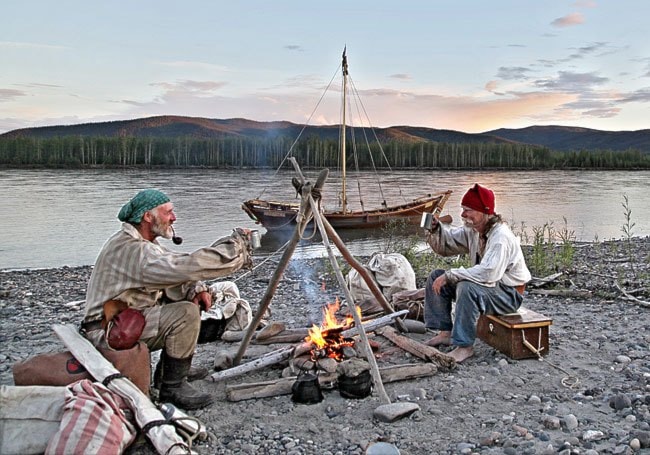For 32 days, a pair of German adventurers sailed, camped, and tried their best to live like Canadian fur traders did 200 years ago.
Joachim “Red Badger” Kreuzer and Manfred Schroter departed from Whitehorse earlier this summer with the aim of reaching Circle, Alaska. It was their second attempt, after their replica York boat got hung up on two sand bars at Lake Laberge last year and they had to abandon the vessel.
The two have been members of New Historical Adventure, a historical re-enactment group in Germany, for decades.
More determined than ever, the pair set off from where they left off last year on June 27.
Aboard their 6.7-metre-long boat named Confiance, they faced strong headwinds for the first two days and could only manage a distance of 29 kilometres.
By day three, the weather had cleared and a tailwind was propelling them forward to their destination of Circle, Alaska.
They travelled 65 kilometres that day, which was closer to their initial goal of rowing 75 kilometres per day.
Four grueling weeks and 1,200 kilometres later, they disembarked in the tiny town of Circle, completing a trip that was three years in the making.
At the end of the 19th century, Circle was an important unloading point for supplies shipped up the Yukon River from the Bering Sea.
Along the way Kreuzer and Schroter, clad in traditional clothing from the era, attracted a fair bit of attention.
Curious boaters on the Yukon River would wave and yell at the Germans, even inviting them to supper one evening.
Two men canoeing the river had caught some northern pike during the day and wanted to share their catch with the adventurers, who contributed butter and rum to the meal.
Kreuzer disagreed with the suggestion that rowing 1,200 kilometres can be a monotonous affair, saying there was always something to do.
“Sometimes I sang old songs and Manfred would join in,” he said from his home outside of Cologne, Germany.
“We talked about everything: the experience, what we would film next, the people we met. Sometimes we’d go one or two hours without talking, just enjoying the nature around us.”
The pair plan on turning the footage they shot into a short film for German television.
They also want to show it off to potential sponsors at an upcoming international boat show in Dusseldorf.
They hope it’ll entice sponsors to fund their next trip.
Kreuzer is self-employed and Schroter works in security. The trip was mostly funded out of their own pockets and cost close to $180,000.
The footage is chock full of the encounters they made this summer.
In Dawson City, they met up with a group of women from Vancouver they’d previously run into. They convened at the Sourdough Saloon one night, where Kreuzer tried the famous Sourtoe Cocktail.
“I’d had a lot of rum by then, so I couldn’t smell the toe,” he said with a laugh.
In Dawson, they also traded a spare sail for three days’ worth of bison meat.
At Fort Selkirk, Kreuzer met a First Nation elder who said he could help with the German’s bout of giardiasis, or beaver fever.
Symptoms of the parasitic infection include loss of appetite, diarrhea and stomach cramps.
“It wasn’t easy to row and have this problem,” said Kreuzer, who had been losing weight every day.
“The man examined me with an eagle feather. He said he found a problem and would make a special tea for me, which was made with black willow leaves. After the third day of drinking it, the problem was completely gone.”
Another night, they watched as a black bear tried in vain to cross a river, which separated it from the Germans.
The strong current prevented the animal from crossing but the pair had their musket ready anyway.
“I was happy because we had only brought dinner for two,” Kreuzer joked.
“We had a hunting licence but we never had to use the weapon except for training purposes. We saw a lot of squirrels and chipmunks but we were never desperate enough for food to shoot them.”
The York boat, meanwhile, remains in the small town of Central, Alaska, where it will be put on display at the Circle District Museum. Kreuzer was told it would cost over 20,000 euros to ship the boat back to Germany, as they’d have to transport it to either Fairbanks or Anchorage first.
In the end, he said, he’d rather leave it in Alaska for people to visit and learn more about.
“It came in on a one-way ticket,” he said.
“Last year, the experience we had wasn’t great. But now we did it and in the end, it was like a full circle, which is where we finished.”
Contact Myles Dolphin at myles@yukon-news.com
